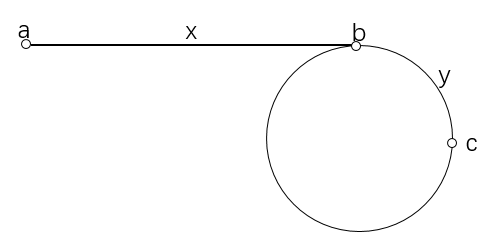算法
(链表,快慢指针扫描) O(n)
本题的做法比较巧妙。
用两个指针 first,second 分别从起点开始走,first 每次走一步,second 每次走两步。
如果过程中 second 走到null,则说明不存在环。否则当 first 和 second 相遇后,让 first 返回起点,second 待在原地不动,然后两个指针每次分别走一步,当相遇时,相遇点就是环的入口。

证明:如上图所示,a 是起点,b 是环的入口,c 是两个指针的第一次相遇点,ab 之间的距离是 x,bc 之间的距离是 y。
则当 first 走到 b 时,由于 second 比 first 多走一倍的路,所以 second 已经从 b 开始在环上走了 x 步,可能多余1圈,距离 b 还差 y 步(这是因为第一次相遇点在 b 之后 y 步,我们让 first 退回 b 点,则 second 会退 2y 步,也就是距离 b 点还差 y 步);所以 second 从 b 点走 x+y 步即可回到 b 点,所以 second 从 c 点开始走,走 x 步即可恰好走到 b 点,同时让 first 从头开始走,走 x 步也恰好可以走到 b 点。所以第二次相遇点就是 b 点。
另外感谢@watay147提供的另一种思路,可以用公式来说明:a,b,c,x,y 的含义同上,我们用 z 表示从 c 点顺时针走到 b 的距离。则第一次相遇时 second 所走的距离是 x+(y+z)∗n+y, n 表示圈数,同时 second 走过的距离是 first 的两倍,也就是 2(x+y),所以我们有 x+(y+z)∗n+y=2(x+y),所以 x=(n−1)×(y+z)+z。那么我们让 second 从 c 点开始走,走 x 步,会恰好走到 b 点;让 first 从 a 点开始走,走 x 步,也会走到 b 点。
时间复杂度
first 总共走了 2x+y 步,second 总共走了 2x+2y+x 步,所以两个指针总共走了 5x+3y 步。由于当第一次 first 走到 b 点时,second 最多追一圈即可追上 first,所以 y 小于环的长度,所以 x+y 小于等于链表总长度。所以总时间复杂度是 O(n)。
C++ 代码
/**
* Definition for singly-linked list.
* struct ListNode {
* int val;
* ListNode *next;
* ListNode(int x) : val(x), next(NULL) {}
* };
*/
class Solution {
public:
ListNode *entryNodeOfLoop(ListNode *head) {
if (!head || !head->next) return 0;
ListNode *first = head, *second = head;
while (first && second)
{
first = first->next;
second = second->next;
if (second) second = second->next;
else return 0;
if (first == second)
{
first = head;
while (first != second)
{
first = first->next;
second = second->next;
}
return first;
}
}
return 0;
}
};


#### 一种小聪明的的方法
/** * Definition for singly-linked list. * struct ListNode { * int val; * ListNode *next; * ListNode(int x) : val(x), next(NULL) {} * }; */ class Solution { public: ListNode *entryNodeOfLoop(ListNode *head) { while(head){ if(head->val > 1000){ head->val -= 1000; return head; } head->val += 1000; head = head->next; } return NULL; } };牛逼
66h
思路好呀hhh
吊爆了
可以,面向测试用例编程牛逼,利用val的范围,相当于将走过的节点标记了,第二次走就会被发现哈哈哈哈
class Solution {
public:
ListNode entryNodeOfLoop(ListNode head) {
if(head==NULL)return head;
vector[HTML_REMOVED] arr(510,0);
auto p=head;
while(p){
arr[p->val]++;
if(arr[p->val]>1){
//cout<<;
break;
}
p=p->next;
}
p->val;
return p;
};
我是你的改进版hhh
### 哈希表真好用,哈哈
# Definition for singly-linked list. # class ListNode(object): # def __init__(self, x): # self.val = x # self.next = None class Solution(object): def entryNodeOfLoop(self, head): """ :type head: ListNode :rtype: ListNode """ ids = {} k=1000 while k>0 and head: if id(head) in ids: return head ids[id(head)]=1 head = head.next k-=1 return None就题而论,hash,确实简单
class Solution { public: ListNode *entryNodeOfLoop(ListNode *head) { int N[1010] = {0}; while(head){ if(!N[head->val]) N[head->val] = 1; else return head; head = head->next; } return NULL; } };用哈希表确实简单
class Solution { public: ListNode *entryNodeOfLoop(ListNode *head) { unordered_set<ListNode*> s; for(auto p = head;p!=nullptr;p = p->next) { if(!s.insert(p).second)return p; } return nullptr; } };为什么我用访问数组写,说我超时呢?
求大佬指教!
/
* Definition for singly-linked list.
* struct ListNode {
* int val;
* ListNode next;
* ListNode(int x) : val(x), next(NULL) {}
* };
/
class Solution {
public:
ListNode entryNodeOfLoop(ListNode head) {
vector[HTML_REMOVED]vis(505,-1);
auto p=head;
auto q=head;
while(p&&vis[p->val]==0){
vis[p->val]=1;
p=p->next;
}
return p; }};
第一次相遇后,第二次相遇前,first和second的速度变成一样的了?
是的,就是需要一样的,速度要改回来,画个图很清楚的
class Solution { public: ListNode *entryNodeOfLoop(ListNode *head) { if (!head) return nullptr; auto fast = head, slow = head; while (fast && fast->next && fast != slow) { fast = fast->next->next; slow = slow->next; } if (!fast || !fast->next) return nullptr; //无环 slow = head; while (fast != slow) { fast = fast->next; slow = slow->next; } return fast; } };这样写为什么wrong answer啊?求各位大佬帮忙解释一下
因为你第一个循环都不能进入,刚开始的时候你的定义fast是等于slow的
奥~懂了懂了,昏头了,谢谢大佬指点
class Solution {
public:
ListNode entryNodeOfLoop(ListNode head) {
ListNode *now=head;
while(now!=NULL)
{
if(now->val<0)
{
now->val=-now->val;
return now;
}
else
{
now->val=-now->val;
now=now->next;
}
}
return NULL; }};
//没想到吧
/** * Definition for singly-linked list. * struct ListNode { * int val; * ListNode *next; * ListNode(int x) : val(x), next(NULL) {} * }; */ class Solution { public: ListNode *entryNodeOfLoop(ListNode *head) { ListNode* first=head; ListNode* second=head; while(first && second) { first = first->next; second=second->next; if(second->next) second=second->next; else return NULL; if(first == second) break; } second=head; while(first!=second){ first=first->next; second=second->next; } return first; } };这样写acwing可以过,牛客不可哎
acwing的数据还是稍水了一点
我是这样写的哈:
class Solution { public: ListNode *entryNodeOfLoop(ListNode *head) { if(!head) return nullptr; ListNode* l = head; ListNode* r = head; while(r && r->next) { r = r->next->next; l = l->next; if(r == l) { r = head; while(l != r) { l = l->next; r = r->next; } return l; } } return nullptr; } };first = first->next; second = second->next; if (second) second = second->next; else return 0;y总,这一段while循环里面的if条件我觉得应该是second->next,因为如果链表没有环且有偶数个节点,最后second就越界了。
这个代码有什么问题呢
/
Definition for singly-linked list.
class ListNode {
int val;
ListNode next;
ListNode(int x) {
val = x;
next = null;
}
}
/
class Solution {
public ListNode entryNodeOfLoop(ListNode head) {
if(head==null||head.next==null) return null;
ListNode first=head;
ListNode second=head;
while(first!=null&&first!=second)
{
first=first.next;
second=second.next;
if(second!=null)
second=second.next;
else return null;
}
first=head;
while(first!=second)
{
first=first.next;
second=second.next;
}
return first;
}
}
while(first!=null&&first!=second),上两行不是把first和second都赋值成head了吗改成
while(first!=null && second != null)突然明白,谢谢大佬,昨天想了一个多小时!
y总,我想问下if (!head || !head->next) return 0;不是保证了链表为空或者只有一个结点的话输出null,那为什么输入[1],0,时,还能输出1呀,不应该是null?
输入[1], 0表示一个包含一个点的自环。输入[1], -1才表示一个长度是1的链表。
可以直接用map,也通过了,代码如下:
class Solution { public: ListNode *entryNodeOfLoop(ListNode *head) { map<ListNode*,int> mp; while(head) { if(mp[head]) return head; mp[head]=1; head=head->next; } return NULL; } };可以的,不过map会多用 O(n)空间,而且时间也会多一个 O(logn)。
爱上这个网站了 如果大佬用的是python就好了
哈哈加油,活动页面里有不少其他同学打卡的python代码~
求助大佬,为什么我的代码的输出结果不对呢?
样例中输出编号为2的结点val 3,我输出了编号为4的val 5
class Solution { public: ListNode *entryNodeOfLoop(ListNode *head) { if(!head || !head->next) return 0; ListNode *fast = head; ListNode *slow = head; ListNode *meet = NULL; while(fast){ //偶数次退出 slow = slow->next; fast = fast->next; if(!fast) return 0; //奇数次退出 fast = fast->next; if(fast == slow){ meet = slow; break; //相遇 } } while(head && meet){ if(head == meet) return head; head = head->next; slow = slow->next; } return NULL; } };if (first == second) { first = head; while (first != second) { first = first->next; second = second->next; } return first; }second不是应该走两步嘛,为什么不是second=second->next->next
我是菜鸡请指教
在两个指针第一次相遇以前,second每次走两步;相遇之后,second每次走一步~
懂了,谢谢大佬!
客气啦
这个框框应该咋弄呀
```
代码段
···
这样就可以啦